The Awair Element is an elegant, simple, and above all, reliable air quality monitor that comes from the Awair company, one of the leaders in this type of product on the market. As someone who has reviewed lots of air purifiers, I understand the importance of having an accurate air quality monitor to help me determine the effectiveness of the purifiers I test.
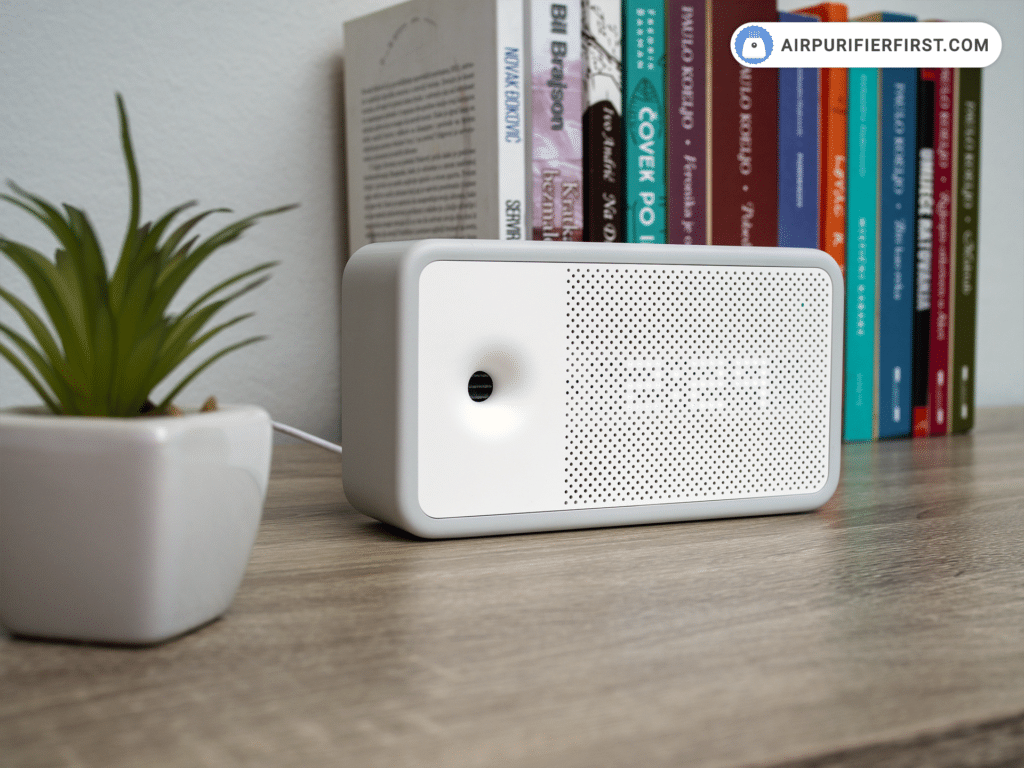
Table of Contents
- In a Hurry? Here’s a Quick Summary of the Awair Element!
- Specifications
- Sensors Types & Accuracy
- Measured Data Reporting
- Cleaning & Calibrating
- Design & Build Quality
- Awair Element Air Quality Monitor – Video Review
- FAQ on Awair Element
- Does the Awair Element work with a smart app?
- Does this air quality monitor have a display?
- How accurate is the Awair Element air quality monitor?
- What is the warranty for this air quality monitor?
- Does the Awair Element run on batteries?
- Does the Awair Element detect radon?
- Will the Awair Element detect gas leaks from a stove or heating unit?
- Pros and Cons
- Final Thoughts
What sets the Awair Element apart from other monitors is the use of five different sensors to determine real-time air quality. It measures temperature, humidity, CO2, TVOCs, and PM2.5. It presents this data in an attractive graphical format through the Awair Home smart application.
I was particularly impressed with the simplicity of setting up the Awair Element. The user manual was easy to follow, and the monitor itself was intuitive. It connected seamlessly to my home Wi-Fi network, and I was able to start monitoring the air quality in my home within minutes.
During my testing, the Awair Element provided consistent and reliable data, which is essential for anyone looking to understand and improve the air quality in their home. The graphical representation of the data in the Awair Home app made it easy to track changes in air quality over time and identify potential sources of pollutants.
According to EPA studies, the average American spends 90% of their time indoors. With this in mind, it is crucial to understand the air pollution levels in your home. Monitoring indoor air quality can help identify potential air pollutants indoors.
Overall, I would highly recommend the Awair Element to anyone in the market for an air quality monitor. Its simplicity, reliability, and attractive design make it a standout product in its category, and the data it provides can be invaluable in improving the air quality in your home.
In a Hurry? Here’s a Quick Summary of the Awair Element!
- Comprehensive Sensors: The Awair Elements air quality monitor is equipped with five built-in sensors that measure temperature, humidity, CO2, TVOCs, and PM2.5 levels in the air.
- Accurate PM2.5 Sensor: In testing, the PM2.5 sensor showed an accuracy of around ±13.68%, ensuring that users can trust the device’s readings.
- Smart App: The device can connect to a smart app that provides additional displays, historical air quality tracking, and visually appealing real-time value displays, making it easy to monitor air quality and take action when necessary.
- Warranty: The Awair Elements air quality monitor comes with a 1-year warranty.
Specifications
Awair Element is characterized by many specifications that I will present in the table below:
| Manufacturer | Awair |
| Model | Element |
| Dimensions | 6.1 x 3.3 x 1.8 inches (15,4 x 84,7 x 4,5 cm) |
| Weight | 1.15 lb (0,52 kg) |
| Sensor Types | Temperature, humidity, CO2, VOCs, and PM2.5 |
| Particle Detection Range | 0 – 1,000 µg/m³ |
| Bettery | No |
| Smart App | Yes |
| Warranty | 1-year |
Sensors Types & Accuracy
As I have mentioned several times before, Awair Element uses as many as 4 sensors to precisely measure air quality in real-time. This device detects temperature, humidity, CO2, VOCs, and PM2.5 in real-time.
Awair Element has built-in pre-calibrated sensors from various manufacturers. In the table below, you can see the types of sensors this device uses, their accuracy, and how reliable they are.
| # | Sensor | Type | Range | Accuracy |
|---|---|---|---|---|
| Temperature | Sensirion SHT31 | Complementary metal-oxide-semiconductor sensor (CMOS) | 0 – 90°C (32 – 194°F) | ±0.2°C |
| Relative Humidity | Sensirion SHT31 | Complementary metal-oxide-semiconductor sensor (CMOS) | 0 – 100% RH | ±2% RH |
| Carbon Dioxide (CO2) | Amphenol-Telaire T6703 | Non-Dispersive Infrared Sensor (NDIR) | 400 – 5,000ppm | ±75ppm or 10% (whichever is greater) |
| Volatile Organic Compounds (TVOC) | Sensirion SGP30 | Multi-pixel metal oxide gas sensor | 20 – 36,000ppb | ±15% |
| Fine Dust PM2.5 | Honeywell HPMA115S0 | Laser-based light scattering sensor | 0 – 1,000 µg/m³ | ±15 µg/m³ or 15% (whichever is greater) |
Even though all the sensors in the Awair Element are calibrated, and the manufacturers guarantee their accuracy, as with every air quality monitor I test, I conducted a test on the PM2.5 sensor to determine how much it deviates.
In the graph below, you can see the results of this testing. It is noticeable that Awair Element and the sensor I compared it to almost overlap in some places, resulting in nearly minimal differences and deviations.
The sensor I used as a reference value is an outdoor sensor located in a government institution near my location, and it is reliable and very trustworthy. I compare every air quality monitor I test with this sensor, which makes testing and comparing the monitors much easier for me.
This test lasted for 7 hours, during which I tested PM2.5 particles in real-time. This means that this test refers only to PM2.5 sensors, which, in my opinion, are definitely the most important for an indoor air quality monitor. After reading the data, I calculated the deviation, which is a negligible ±13.68% (refer to the graph below), which is about 4% less than what the manufacturer claims the deviation for this sensor is.
Interestingly, Awair Element is much more precise and reliable than some budget air quality monitors, such as the IKEA VINDRIKTNING, which has a deviation of up to ±20.00%.
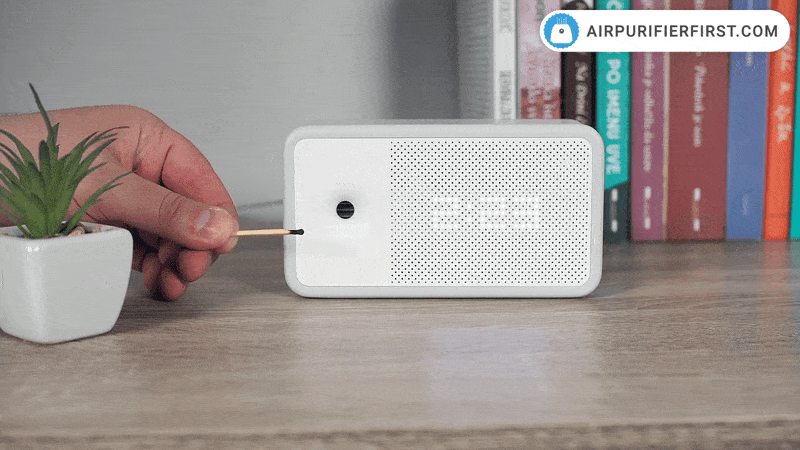
Another feature that sets Awair Element apart is its highly accurate VOCs sensor, which has an accuracy of an incredible ±15%. Given that many air purifiers do not have VOC sensors, this addition can be of great benefit. For example, Winix 5500-2 has a sensor that detects odors in real-time, but in my opinion, this sensor in Awair Element is much more reliable and accurate, and I would rely on it more.
However, there is one general problem with VOC sensors: these sensors group all VOC sources and then determine the number of VOCs and pollution based on that. Many studies have shown that this is not the best way to measure the concentration of VOCs, which is why I would personally rely only on information about how much VOCs have increased or decreased and not pay attention to the numbers because it does not necessarily mean that the air in the room is polluted. In essence, the ideal would be to measure only one value, such as formaldehyde.
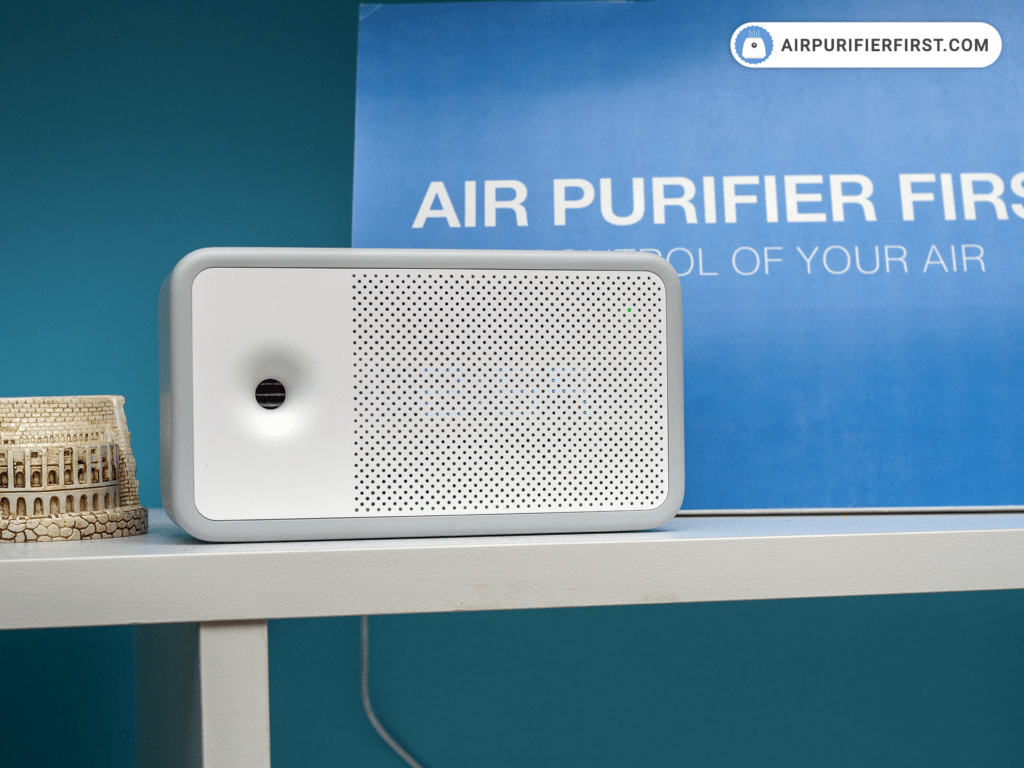
Another interesting metric of the Awair Element air quality monitor is the Awair Score, which is their internal calculation that displays the overall air quality in your room. This parameter takes all the values from all 5 sensors and determines a score of 1-100 for the air quality in your home. From 0 to 60 indicates very poor air quality, from 60 to 80 is moderate, and from 80 to 100 is excellent air quality.
The LED light in the upper right corner of this sensor lights up in three different colors, which indicate the Awair Score, that is, the current air quality in your home. This lamp can shine red, orange, and green.
Measured Data Reporting
In my opinion, one of the most important features of an air quality monitor, besides high-quality sensors, is the detailed, comprehensive, and easily readable display of collected data. Awair Element displays the collected data in two ways: through the display and through the Awair Home smart application.
Personally, I like both ways, and I have to admit that I rarely use the application, even though I’ve been using Awair Element in my living room for more than three months. I only use the Awair Home app when I want to check the air quality in my living room at a specific time.
Display
The Awair Element display comprises numerous LED dots that accurately display numbers, colors, and some textual messages. The dot in the upper right corner is always visible on display, which defines the Awair Score. Essentially, in the central part of the display, you can display the time, Awair Score, temperature, humidity, CO2, VOCs, and PM2.5.
I think each user will choose the data they are most interested in displaying, but perhaps the most comprehensive is the Awair Score, which visually indicates the level of pollution for all parameters and additionally shows the Awair Score.
However, the drawback is that these data are a little harder to read, and you need to get used to them (learn how to read them). The Awair Score screen displays all five elements in the following order: Temperature, Humidity, CO2, VOCs, and PM2.5. For each of these parameters, one of the 5 dots lights up, depending on the value for that parameter, as you can see in the picture below.
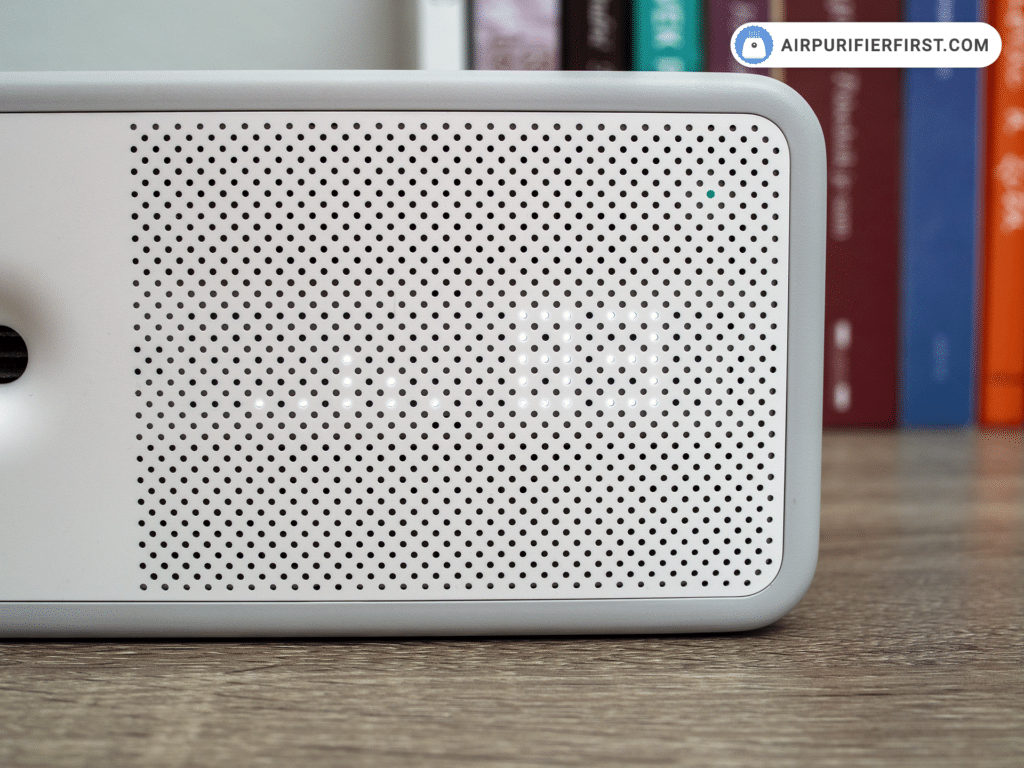
The Awair Element display is innovative and engaging but confusing for many users. Personally, I like it, I like innovations, and it wasn’t difficult for me to get used to it. For users who find the display too complicated, the smart application always displays all the necessary information in great detail.
Awair Home App
First of all, I have to praise the quality of the application, ease of use, and the speed and ease of connecting to the Awair Element air quality monitor. In addition, I would like to point out that this device can’t be connected to modern 5G modems, but you must have a modem that works on a 2.4 GHz Wi-Fi connection.
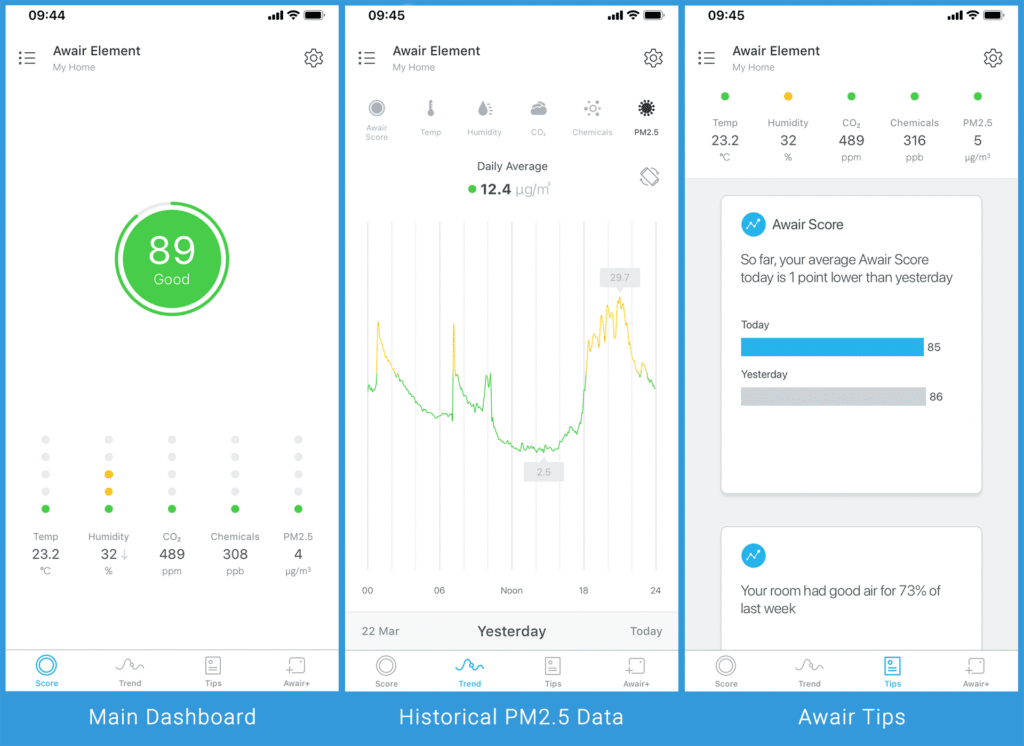
As for displaying data, at the very beginning, you will see a much more detailed display of all readings from all sensors separately. On the top, you will see the Awair Score displayed in a circle. Below it, there is a graphically represented display of LED dots that show the value of each parameter much more precisely than on the main display.
Also, I like the colors, design, and impression of minimalism that the application left on me. At the application’s bottom is a bar where you can choose other displays. One of the most interesting there is the Trend display, which shows historical data for each parameter separately. This is very useful for monitoring and analyzing the air quality in your room.
On the control panel, you can also find Tips, which show some helpful tips directly from Awair, as well as an analysis comparing parameters. For example, currently, under Tips on my app, one of the information says: “So far, your average COs today is 201 ppm higher than yesterday.” Similarly, you will find various charts comparing and displaying this data.
There is also an Awair+ tab for more advanced users who want to use the Awair Element API or export data.
Cleaning & Calibrating
I believe it’s important to thoroughly understand the cleaning and calibration process of the Awair Element sensor. Firstly, I’ve noticed that air inlets tend to accumulate a significant amount of dust over time. Hence, it’s essential to clean and maintain them regularly. This not only ensures accurate readings (especially of PM2.5 particles) but also prolongs the sensor’s lifespan.
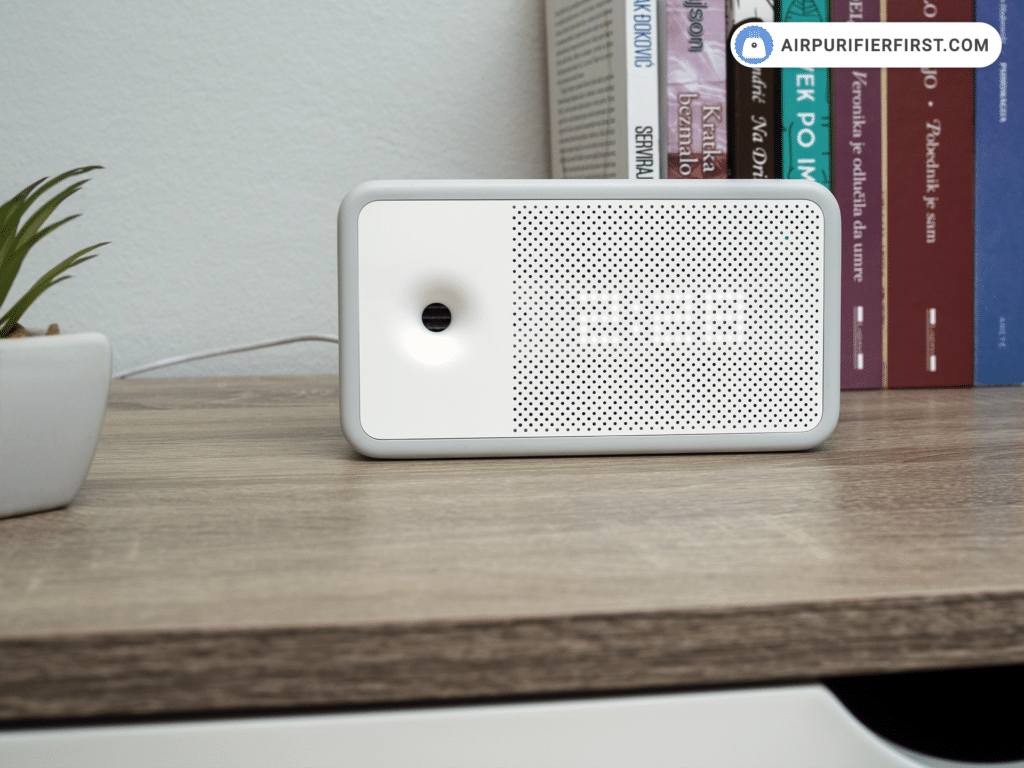
Regarding calibration, it’s important to note that most sensors on the Awair Element come factory calibrated, and there’s no need for additional calibration. However, the TVOC sensor is an exception and requires calibration, especially if it has been exposed to pollutants such as paints, cigarette smoke, aerosols, cleaning materials, and deodorizers.
The calibration process for the TVOC sensor is straightforward and is explained in detail on the Awair support page. All that’s required is to follow the steps through the Awair Home app and complete the process in a few easy steps.
It’s worth mentioning that temperature and humidity sensors don’t require any calibration, but extreme temperatures can potentially damage them. On the other hand, the carbon dioxide sensor uses AVC Logic for ongoing calibration every 14 days. It’s also essential to regularly clean the air inlets to prevent the buildup of dust and ensure accurate readings for the PM2.5 sensor.
Design & Build Quality
As an air purifier reviewer, I have come across many different air quality monitors, but in my opinion, the Awair Element is the best-designed one on the market. While tastes may vary, I appreciate the unique way it displays data, its sleek and modern appearance, and the high-quality plastic used in its construction. When I hold the Awair Element, I feel a premium quality unmatched by other monitors in its class.
One of the standout features of the Awair Element is its fan, which is of excellent quality and almost silent. It’s hard to notice that the device even has a fan. Another impressive feature is that it’s a lightweight and portable device that can operate on batteries. However, this also means it depends on a power source, limiting its placement options.
I have tested many air quality monitors, but not many come with a built-in battery. The Temtop M10i is one of the few that does, but its battery only lasts a few hours. Therefore, I believe this feature still needs further development, and manufacturers should work on improving it.
Another portable air quality monitor I use regularly is the Temtop LKC-1000S, which also runs on batteries. However, it is better suited for on-the-go use rather than placing it on a shelf or a desk.
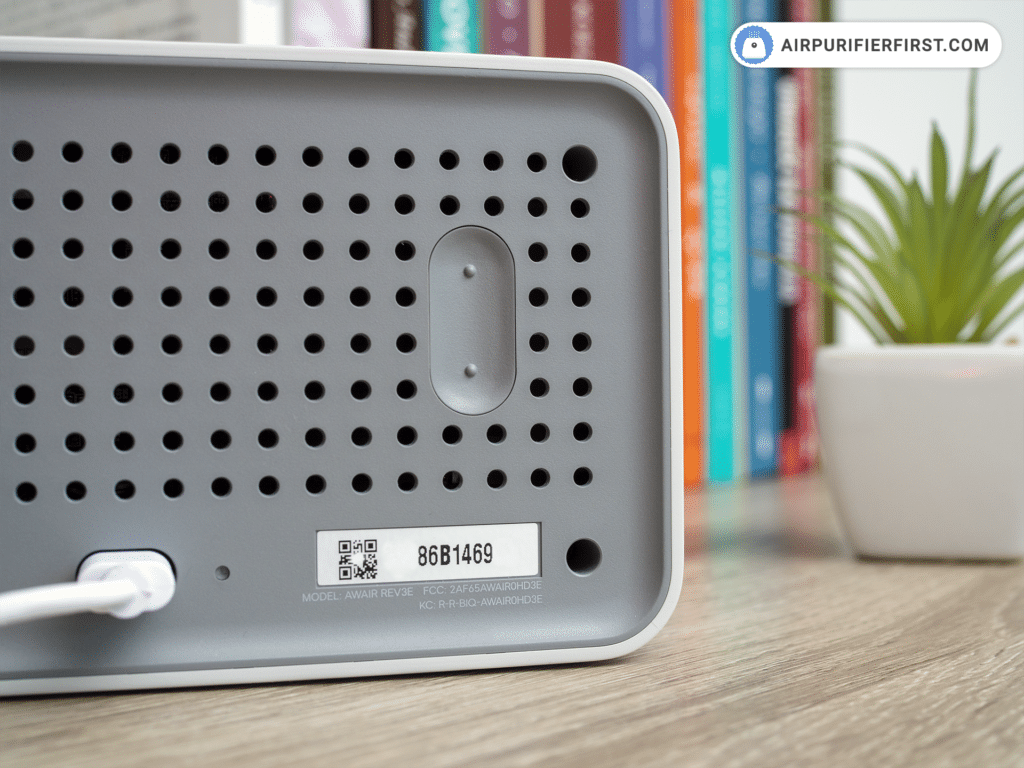
The Awair Element features an air intake vent and LED lights on the front that display various readings, including the current time, all sensor readings simultaneously, and individual readings from each sensor.
On the back, there are buttons that allow you to change the display of the readings. There is also a small button that can only be pressed with a needle or a similar object that serves as a reset button for the device. Overall, the Awair Element is a modern and elegant air quality monitor that can blend in with any interior.
Airflow
The Awair Element has a small air intake vent on the front that allows air to pass through all five sensors, which measure the current air quality and send the data further.
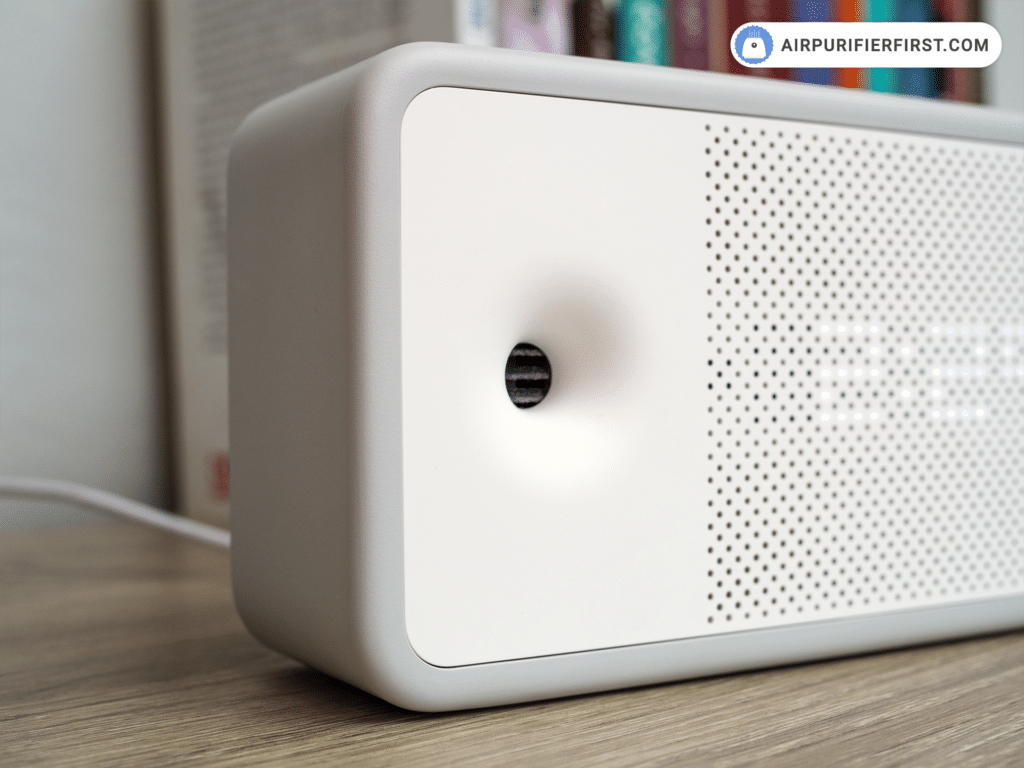
The air then exits through the vents on the back of the device. It is essential to ensure that neither the intake nor the exhaust vents are blocked, as this could damage the device.
What Comes with the Device?
The Awair Element comes with one air quality monitor, a power cable, an adapter, and a user manual.
There is no preparation required before the first use, as all you need to do is download the Awair Home app from the iOS or Android store and follow the steps to connect the device. I highly recommend doing this, especially if you want to keep a historical record of the air quality in your home.
Awair Element Air Quality Monitor – Video Review
Watch the video review in which we showed all the tests performed on this air quality monitor + to get a better picture of this air quality monitor.
FAQ on Awair Element
Does the Awair Element work with a smart app?
Yes, it does! The Awair Home app is available for Android and iOS devices, allowing you to connect to the Awair Element air quality monitor.
Does this air quality monitor have a display?
Yes, the Awair Element has a display showing all the necessary information and data the device collects in real-time.
How accurate is the Awair Element air quality monitor?
According to the factory specifications, the Awair Element is a highly accurate air quality monitor that does not have significant deviations. I have even tested the PM2.5 sensor on this device, which has shown exceptional results, with a deviation of only ±13.68%, which is outstanding and absolutely acceptable for such a device.
What is the warranty for this air quality monitor?
The Awair Element comes with a one-year warranty.
Does the Awair Element run on batteries?
Unfortunately, the Awair Element doesn’t run on batteries, so you need to plug it in to power it up.
Does the Awair Element detect radon?
Although it has five different sensors, the Awair Element air quality monitor can’t detect radon.
Will the Awair Element detect gas leaks from a stove or heating unit?
Unfortunately, it will not. The Awair Element uses a carbon dioxide sensor, which cannot detect carbon monoxide, which is essentially the smoke from a stove or furnace. For this purpose, you need a smoke detector.
Pros and Cons
To revise, here are the advantages and disadvantages of the Awair Element:
Thanks! I’d love to hear from the company, it seems like they’ve been silent for a while and stripped a lot of useful functionality out of the app. My Element arrived a couple of days ago, but I’m hesistant to buy another until we get some confirmation they have a roadmap and a plan!
Perhaps you could use your platform to get a statement?
Have you spoken to Awair support at all? It seems they’ve stripped out a lot from the app. Are they still supporting the Element?
I haven’t. But, as I understand it, they’ve discontinued support for the older Awair Element model, the one with the wooden body (v1 model), and the Glow.
However, this Awair Element I reviewed works exceptionally well. I’m currently using it in my living room and check the air quality daily through the app without any issues!